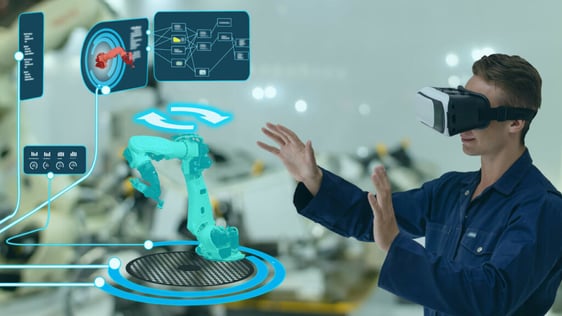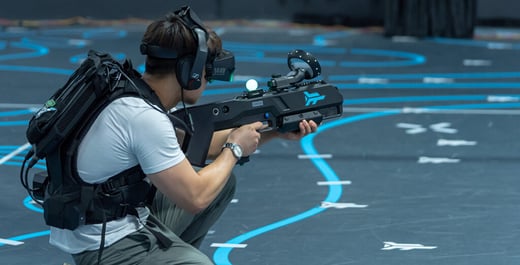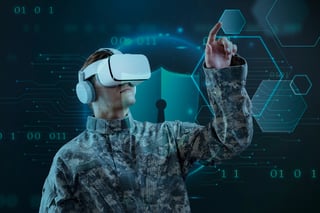- June 21, 2022
VR Immersion for Training and Entertainment
The world of virtual reality (VR) has been touted as the next big thing in the computing space for decades. The promise of a true VR immersion environment has been made by many different inventors and entrepreneurs, however this is still to materialize. The visual side of virtual reality has been consistently improving each year with higher fidelity graphics pushing the limitations of hardware as soon as it’s released. However, despite the advances in visuals, there is still a major setback to true immersion – the sense of touch. Without this a virtual world will always feel fake and empty, and despite the effectiveness of VR in its current state, the current force feedback systems leave much to be desired. This article will explore the importance of immersion in VR applications and the future of the technology.
Importance of VR Immersion

Regardless of the specific industry, keeping the user immersed in a virtual environment is key to deriving value from the experience. For example, if someone is training in a virtual environment, the lack of immersion will result in a lower intensity experience and thus a lack of focus because it doesn’t feel real. This means that the virtual training will lose most of its effectiveness.
Customizable virtual environments allow the creation of complex situations that would be too expensive or too dangerous to replicate. This, coupled with true immersion by the engagement of as many of the 5 senses as possible, will result in highly effective and low-cost training.
Advantageous of Virtual Reality in Entertainment
 VR headsets for the gaming industry are still relatively expensive and are not used by most gamers. However, the technology is becoming cheaper after each iteration, and thus it is only a matter of time before a VR headset is a standard gaming peripheral. This will result in an explosion of VR titles.
VR headsets for the gaming industry are still relatively expensive and are not used by most gamers. However, the technology is becoming cheaper after each iteration, and thus it is only a matter of time before a VR headset is a standard gaming peripheral. This will result in an explosion of VR titles.
The next step is an accurate and low-cost force feedback system that can result in a very enjoyable experience that will immerse a gamer into a virtual world to a deeper degree than by visual immersion alone. This immersion means that gamers stay engaged longer, and this is good business for publishers as many companies rely on in-game marketing.
The $134 billion gaming industry will be the major driver in VR adoption.
Virtual Reality In Military Training
 The military has been using VR immersion in training for many years. All branches of the military make use of the technology in some form. A key use for VR is in flight training.
The military has been using VR immersion in training for many years. All branches of the military make use of the technology in some form. A key use for VR is in flight training.
Using VR as a training medium in the air force tests pilots in scenarios that would otherwise be too risky. Unfortunately, the high total cost of ownership (TCO) of these systems means there is a lack of availability and the simulators are used mainly for re-certifying experienced pilots as they need to demonstrate the ability to handle dangerous situations.
Commercial VR Immersion
 The use of VR immersion has found its place in a wide range of applications in the commercial space, from 3D design and art, to construction and training. Technicians who will operate in high-risk environments like mining or chemical processing plants can also benefit greatly from VR.
The use of VR immersion has found its place in a wide range of applications in the commercial space, from 3D design and art, to construction and training. Technicians who will operate in high-risk environments like mining or chemical processing plants can also benefit greatly from VR.
In industrial VR applications, force feedback is critical to create the kind of immersion that improves the effectivity of the training.
Force Feedback in VR
Force feedback in VR immersion applications has mainly been relegated to large training simulators for pilot training, and large gaming installations. Force feedback in these applications is limited to the types of forces they can simulate. Furthermore, these systems are large and extremely expensive and cannot be used on small-scale VR applications. Devices that can be used for small-scale force feedback can typically only vibrate at various intensities, thus limiting their effect on immersive experiences.
Magnetic Force Feedback
Magnetic force feedback is a new technology that has a wide range of benefits. Its accuracy, high fidelity, and quiet operation are ideal for VR applications. Furthermore, a simple change in the control loading software of the magnetic actuator can simulate a wide range of real-world effects. This makes it orders of magnitude more immersive than just a generic vibration or any other force feedback system.
Magnetic force feedback is the next step in the creation of a truly immersive experience across all industries that employ VR, and can bring the technology to areas where the cost was previously prohibitive. This new force feedback technology coupled with high-quality gaming and gamification of training VR systems will democratize future access to simulation.
